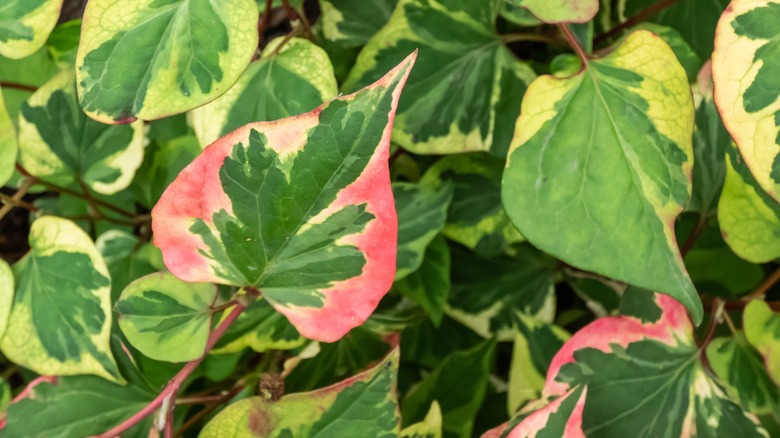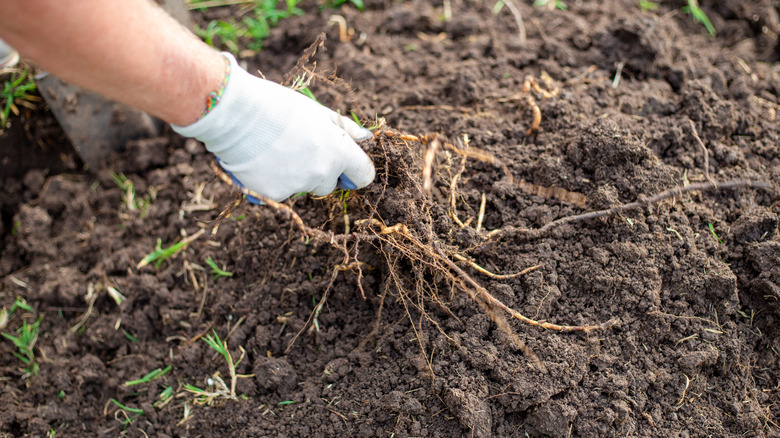How To Get Rid Of Fast-Growing Chameleon Plants Before They Take Over Your Yard
Heart-shaped green and yellow leaves edged in bright pink seem like they'll make chameleon plants (Houttuynia cordata) a dazzling addition to your landscaping. It goes by many names, some among them as appealing as its leaves and white flowers. Also known as rainbow plant, heart leaf, or less-charming "fish mint", chameleon plants look lush and lovely carpeting a shady floor of a tree grove. But don't be lured in by its innocent facade. These striking plants have shocking secret superpowers. They spread like wildfire and are impervious to most herbicides.
Houttuynia cordata are native to Southeast Asia and are considered invasive in several parts of the eastern U.S. If you don't want this sneaky beauty to take over your yard, you're going to have to put on some gloves, grab a trowel, and dig in. There isn't much in the way of chemical warfare you can wage on the plant. However, if your spot is horribly infested, you can give a bit of glyphosate a try with extreme caution.
If you're searching for a pretty lawn alternative, look toward other ground cover plants you should grow instead of grass in your yard. Otherwise, chameleon plants may soon be choking out all other plant life around your home.
Catch the chameleon plant early!
These deceptively lovely invasives spread both by seeds and by underground rhizomes. Rhizomes are actually stem shoots rather than roots. Plants that spread through rhizomes have a reputation for taking over a landscape, and Houttuynia cordata is certainly among the most pushy of these plants.
The key with chameleon plants is to keep them from spreading beyond control, and hand-pulling is a tried-and-true way to get rid of weeds in your garden or yard. Houttuynia cordata love wet soils and even standing water. If you have some growing in a dry area, it may not be as apt to spread as it would in moist spots. One possible preventative tactic is if your region has a rainy season, take on your plant removal before it begins.
If you notice your chameleon plants spreading beyond where you'd like them and beyond what you can remove by pulling them out, the professionals at CS Designer Landscaping have a suggestion. Dig a 1-foot-deep trench around a large clump of the plant. Inside the trench, you'll see the ends of rhizomes running through the soil. Remove as many of them as possible, put them in a bag, and throw them away. Refill the trench with fresh soil. Do not put the rhizomes in your compost pile, or all your hard work will be for naught.
Reach for harsh chemicals as a last resort
Don't bother with basic pesticides like RoundUp or Weed-B-Gon; chameleon plants will laugh in their faces. One worthy opponent for these tough guys is glyphosate, but with its high potency and potential to kill other plants around it, reach for this solution only out of desperation. This is one of several ingredients in Round Up, but its concentrations of glyphosate may not be high enough to be effective. Always think twice about using weed-killing products that contain noxious chemicals.
To use this heavy-handed method, start by trimming back the plants to the soil. Brush or drip a bit of the glyphosate onto the cut stems that are still in the soil, being careful not to get the solution onto anything but the chameleon plants' stems. Dealing with the glyphosate with a paintbrush or a medicine dropper increases your ability to control where you're applying the pesticide. You will likely have to repeat this for a few seasons, but using it carefully for two years should take care of your chameleon plant problem for good.


